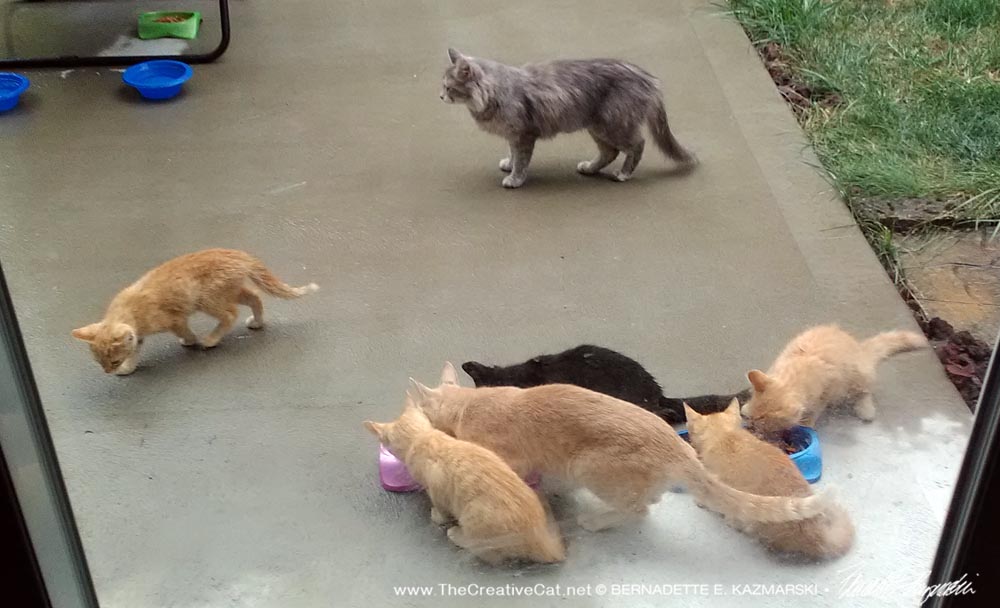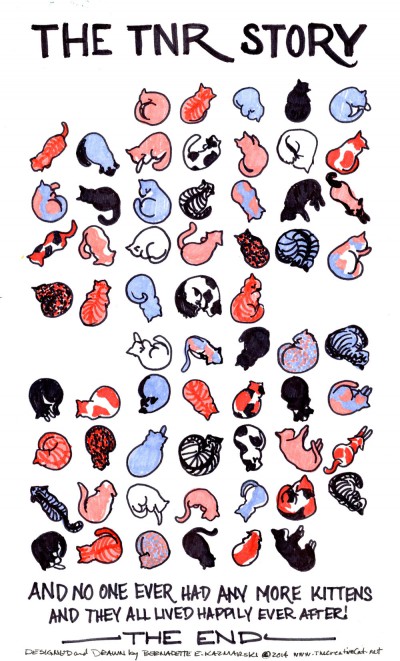Stray and Feral Cats and TNR

TNR or “trap-neuter-return”, or TNVR because a rabies vaccine is always a part of the process, can be a very controversial topic, but when you engage in a conversation it turns out that it’s really the “return” part that draws the most objection. From people who don’t understand the nature of feral or unsocialized cats to those who just don’t like any cats, many people don’t understand why, when you worked so hard to catch the cat and went to the trouble of neutering and vaccinating it, would you go and put it back outside?
Sometimes it’s sad but necessary, especially if cats are friendly, or their health is compromised, or they are just young kittens, but there is no home or shelter where they can live and be cared for. If they are returned to the safety of a caretaker they at least get the opportunity to live out their lives and be fed and monitored by a person who cares about them.
But the goal of TNR for all concerned is not just to sterilize cats so they can’t reproduce. For both cat lovers and those who find them to be filthy pests another important goal is to reduce the population of free-roaming cats. We cat lovers want them safe in loving homes that understand their temperament, opponents just want them gone.
But while studies show TNR on its own does stabilize the population fairly quickly, it really doesn’t reduce the population very quickly. If there is a high rate of abandonment of cats in the area often it doesn’t reduce the numbers at all.
Adoption
Studies of stray and feral cat management as far back as 1993 conclude that TNR alone is not an effective way to reduce cat populations. Studies published in 2002 and 2003 and later report the results of studies beginning as early as 1991 that incorporated the removal of kittens and any cat considered adoptable. They showed that the population of even a large colony could be reduced by half or more within a year or two of beginning a monthly trapping and neutering program, and thereafter diligently keeping up with any new cats who showed up as part of the colony.
Outreach
Most of the studies of TNR also put an emphasis on working with caretakers who were already familiar with the cat populations, enlisting their help in assessing the cats in their colonies and in trapping and neutering, and who would be continuing to care for them and managing the colony when they were returned. Rather than calling Animal Control or an organization taking care of the TNR it’s much more successful upfront and ongoing with the support of the people who know the cats already.
But how to find fosters and adopters
With shelter euthanasia of dogs and cats in 1997 estimated at almost 10 million animals euthanized in that year alone, who was going to handle the kittens and adoptable cats from colonies of cats living outdoors, especially if they weren’t immediately adoptable but needed socialization or medical care?
Enter three things that made an impact over the past decade or more and helped to make removing adoptable cats during TNR possible: pediatric spay and neuter, low-cost spay/neuter programs at shelters and freestanding agencies, both of which helped to reduce stray and feral populations overall, and working with rescues who could take unadoptable cats and kittens from the shelters and make them adoptable over time.
We are responsible for domesticated animals
Because we humans are responsible for the animals in our world, be they domestic pets or domestic farm animals or wild animals, I will always say that rescuing animals means rescuing people. Sometimes rescuing a person involves just a little bit of education and resources that they had no idea were available, and off they can go and care for their situation on their own, like people who are feeding stray and feral cats but not spaying and neutering them because they may not have realized the need, and more often not had the money or transportation to get the surgeries and had no idea there was such a thing as a low-cost clinic or TNR.
Often it means guiding them through that process whether it’s helping them trap a colony of cats and getting the cats the care they need from fostering kittens to TNR and setting up a feeding station and shelters for feral cats. After it’s all done, one more person knows the best way to take care of the situation, they have resources and connections and can maintain and also help others.
Sometimes it involves skilled negotiation that doesn’t go as far as you’d like but still helps the animal, like convincing someone to at least spay and neuter their cats and provide food, clean water and a real shelter that will protect their cats and keep them safe and comfortable in any weather.
And sometimes there’s failure when a person refuses help or refuses to do what is recommended for simply selfish reasons and you know the animals will suffer, and there is nothing more you can do. But somehow you’ll work it out to get the cats the help they need.
TNR is the most humane way
Cats go for quantity, not quality—they have adapted to breed as often as possible because they are not only predator, they are also prey, and without assistance from humans tend to have short lives. Still, a colony of cats can grow to 100 more more in just a few years. But they are not wild animals, heading off to the woods where they won’t be disturbed by human activity. Instead they find a place near humans where food and shelter are available because they are domestic animals and intended to live with humans. But this is where the conflict arises, as a colony develops and grows.
(Caution: the following paragraph includes graphic information about inhumane practices in reducing cat populations. I include it because many people I meet who question TNR are not aware that some of these methods are still in active use.)
Through the years and even today, cat populations in more protected places like residential areas, city neighborhoods, industrial areas, even junkyards, are often reduced by poisoning them or rounding them up and shooting them. Animal control agencies can be notoriously cruel with cats, trapping and killing them by drowning or breaking their necks. Even if they are trapped and taken to a shelter, they are typically killed because they aren’t adoptable and shelters don’t have the staff, space or other means to attempt to socialize a colony of stray and feral cats.
There is no reason why cats have to die just because they live in an area where they aren’t wanted. They do the best they can to meet their needs as a domestic animal when humans have failed them by abandoning them. TNR was devised as a humane way to stop the killing of cats who find themselves in these situations.
References
Zaunbrecher and Smith, 1993. Neutering of feral cats as an alternative to eradication programs: https://www.cabdirect.org/cabdirect/abstract/19932290799 (only the abstract is available online)
Lisa A. Centonze, BA, and Julie K. Levy, DVM, PhD, DACVIM, 2002. Characteristics of free-roaming cats and their caretakers: https://www.avma.org/News/Journals/Collections/Documents/javma_220_11_1627.pdf
Julie K. Levy, DVM, PhD, DACVIM; David W. Gale; Leslie A. Gale, BS, 2003. Evaluation of the effect of a long-term trap-neuter-return and adoption program on a free-roaming cat population: https://www.avma.org/News/Journals/Collections/Documents/javma_222_1_42.pdf
Loyd, K. T., and J. L. DeVore. 2010. An evaluation of feral cat management options using a decision analysis network. Ecology and Society 15(4): 10.: http://www.ecologyandsociety.org/vol15/iss4/art10/
Neighborhood Cats Sample TNR Policy Presentation: http://www.spayusa.org/assets/pdfs/sample-tnr-presentation.pdf
“Animal Shelter Euthanasia”, American Humane website 7/16/17: https://www.americanhumane.org/fact-sheet/animal-shelter-euthanasia-2/
“An overview of pediatric spay and neuter benefits and techniques”, Philip A. Bushby, DVM, DACVS, Brenda Griffin, DVM, DACVIM, DVM360 website, 7/16/17: http://veterinarymedicine.dvm360.com/overview-pediatric-spay-and-neuter-benefits-and-techniques
“Early-Age Spay/Neuter”, Clinician’s Brief, March 2012, pp. 71-73. Philip A. Bushby, DVM, DACVS, Mississippi State University: http://www.cliniciansbrief.com/sites/default/files/Early-Age-Spay-Neuter.pdf
I am honored
 This article was awarded a Certificate of Excellence by the Cat Writers’ Association in the 2019 Communications Contest. Click here to read more about the CWA, the contest and the awards.
This article was awarded a Certificate of Excellence by the Cat Writers’ Association in the 2019 Communications Contest. Click here to read more about the CWA, the contest and the awards.
Gifts featuring cats you know! Visit Portraits of Animals
Art With Donation from Portraits of Animals!

This award-winning art was inspired by working in post op at the May 25, 2014 Homeless Cat Management Team TNR clinic. I’ll make a $5.00 donation to HCMT for each poster sold to help spay and neuter more cats so there won’t be so many to rescue. Quantity discounts are available if you want a stack for a clinic or event. Read more about this artwork and purchase a print of this sketch.
signoff]



Pingback: Rescue Story: Friendly, or a Pest? - The Creative Cat
Pingback: Rescue Story: A Friendly One ~ The Creative Cat
I’ve always liked this poster, and I never see the acronym TNR without thinking; if Bob Barker had been listened to, ending his segments on the Price Is Right with his words; “have your pets spayed or neutered”……. where would we be now
Really! Look at all the people who didn’t listen. Thanks on the artwork!
And anyone can do it! I’m the biggest wuss on the planet, and I’ve trapped many cats! The conviction that I’m helping the cats, makes me strong to get them in the trap, then to the spay/neuter clinic. If you feed them, you MUST fix them!
Great post!
You’re exactly right, Vicky! I’ve been really gratified at the caretakers who took over their trapping and learned to use a drop trap like a boss. A few idiots object to spay-neuter–the original caretaker where Mariposa came from would not spay and neuter, just grabbed as many kittens as she could and took them to the shelter, which is really sad because they weren’t socialized. But then she was a heroin addict. We know the right way.